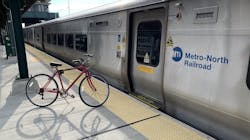MTA's Bike, Pedestrian and Micromobility Strategic Action Plan moves forward with initial steps
Metropolitan Transportation Authority (MTA) officials outlined a series of initial actions being undertaken through its landmark Bike, Pedestrian and Micromobility Strategic Action Plan, which include capital projects enhancing bike and pedestrian access to MTA bridges, additional bike parking infrastructure at subway stations throughout the system and the initial commuter rail stations to pilot improved car-free connectivity to local communities. The Strategic Action Plan, first announced in May, will outline how pedestrians, cyclists and micromobility users can better access MTA facilities and services in collaboration with local governments, advocacy groups and stakeholders.
“Increasing access and connections to MTA services is one of my top goals,” said MTA Chair and CEO Janno Lieber. “Today’s announcement represents the first steps in a comprehensive strategy to provide more car-free access to transit across the New York region. As MTA ridership continues to rise, the actions we unveiled today will upgrade connections to transit for cyclists, pedestrians and micromobility users and bring more riders back to the MTA’s subways, buses, and commuter railroads.”
Two MTA bridges to receive widened and improved shared-use paths
The MTA Board approved the award of a capital project recommended by the Strategic Action Plan to improve cycling and ADA access on the Cross Bay Bridge.
With this project, the MTA will renovate the south approach of the bridge’s shared use path with an ADA-compliant ramp. This capital project is funded in the 2020-2024 Capital Plan and the construction contract will be awarded by the end of 2022. In addition, effective this month the MTA is allowing for cycling across the bridge’s main span through a temporary shared use path where the width safely allows. Cyclists must continue to dismount at the south side until the completion of the new ADA compliant ramp.
In addition, on the Henry Hudson Bridge the MTA will widen the existing lower-level walkway so that it is suitable for shared use and will construct ADA-compliant ramps on both the north and south approaches to this shared use path. This project is funded in the 2020-2024 Capital Plan and the construction contract will be awarded in 2023. Upon completion of the project in 2025, the ban on cycling across the Henry Hudson Bridge will be lifted.
In partnership with NYC DOT – investment in biking to transit
In collaboration with the New York City Department of Transportation (NYC DOT), bike parking infrastructure will be installed at 37 subway stations that currently lack bike racks within 100 feet of station entrances. The MTA provided NYCDOT with this priority list to help focus DOTs ongoing efforts to add bike parking at important transit hubs and stations. The list includes details on suitable locations for bike racks, focusing on outer borough stations near end-of-line areas. The installation of bike parking at these stations will help fill gaps in bike connectivity to transit and reach the authority’s goal of bike parking at 100 percent of subway stations. MTA and NYC DOT will continue this collaboration by exploring opportunities to grow the bicycle network and provide secure covered bike parking near transit.
Piloting car-free connectivity to commuter rail stations
The MTA’s First-Mile/Last-Mile study, commenced earlier this year, has focused on analyzing existing station access and targeting gaps in walking, biking, rideshare, and transit with strategies to improve customer access to stations in our suburban Metro-North Railroad and Long Island Rail Road territories. As commuter railroad ridership continues to surge after Labor Day, improving access to rail stations will help grow ridership and increase connectivity. The MTA developed a First-mile/Last-mile Toolkit for our county and municipal stakeholders to assess their local stations and design pilot programs to improve connectivity. Ten interested communities across the MTA’s commuter rail territory have been selected for pilot projects as part of this study. The MTA's consultant on this study, VHB, will complete station assessment and design of the 10 Pilots, using the FMLM Toolkit, by the end of December 2022, and MTA will continue to coordinate with local stakeholders on their implementation plans.
To further encourage connectivity to MTA services, MTA was awarded a NYSERDA grant to develop a multi-modal trip planning function within the MyMTA App. This function will be rolled out beginning in 2023.
Process and next steps
As the MTA announced in May, the final Bike, Pedestrian, and Micromobility Strategic Action Plan will be released by the end of 2022. The Strategic Action Plan will build on the initial actions announced today and will address how the MTA can improve access to its services and facilities for bikes, pedestrians, and micromobility services. The plan will help to support the growth of sustainable transportation modes, and boost transit ridership by increasing access points to the MTA’s services and facilities. We are working with local governments and other agencies in our service area, such as NYC DOT, to develop this plan. We are also soliciting input from other partners, including our customers, advocacy groups and bike share and micromobility companies.
